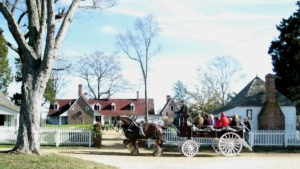
Sotterley Plantation
Horses Pulled Their Weight on This Historic Plantation
44300 Sotterley Lane, Hollywood, MD
Visit the website
VIEW ON MAP | GET DRIVING DIRECTIONS | Follow on Facebook
Standing on the sweeping grounds of Sotterley Plantation, a visitor can easily imagine a bygone era when a horse-drawn carriage brought guests down the grand avenue to the front door of the mansion house. Older than Mount Vernon, with a history that spans three centuries, this restored Tidewater plantation beautifully documents the lives of the influential families that owned the property dating back to 1699. The mission of Historic Sotterley is to preserve, research, and interpret the plantation’s diverse cultures and environments, and its collection of documents, photos and ephemera include significant insight into the roles horses played in everyday life throughout the decades in transportation, labor and sport.
The 1727 inventory of James Bowles, a wealthy trader who owned Sotterley from 1700 to 1727, indicates that he owned “one old draft horse, Sparke, and draft horses Pompey, Gray, Ceasar, Sharper, plus riding horses Swann, Sorrell, Whitefoot and Pegg.” Additionally, he had two spade mares, four breeding mares, two yearling colts and three young horses.
George Plater II, prominent in Colonial government and owner of Sotterley from 1729 to 1755, kept horses for breeding, selling and racing. Chariot rides on the grounds were commonplace.
Sotterley’s brick building, named the Warehouse, dates from 1757 and was used as a stable for most of its history. Work horses were used for farming and transportation during the 1800s. Doctor Walter Hanson Briscoe, owner from 1828 to 1885, traveled by horse-drawn carriage to visit his patients. Francis (Frank) Cane, an enslaved man, was Dr. Briscoe’s coachman.
As Sotterley entered the Colonial Revival in the early 20th century, owner Herbert Satterlee and his daughter, Mabel Satterlee Ingalls, kept horses and rode for pleasure. A large horse barn was built in the mid-1920s. Its twin structure, Sotterley’s remaining barn, still stands. The farm workers continued to care for and use horses for transportation and to draw wagons well into the mid-1900s.
Today, Historic Sotterley spans 95 acres of beautiful land, forest and fields on the banks of the Patuxent River that include 20 historic buildings, a visitor center, over six miles of nature trails, exhibits, tours and special programs. Visitors are invited to picnic on the grounds and interact with Sotterley junior docents during the summer months. Sotterley’s all-volunteer Garden Guild maintains one of the most breathtaking Colonial Revival gardens in the nation. The property is available for weddings and special events.
Its collections include art, furnishings and memorabilia associated with the plantation, as well as artifacts discovered via archaeological digs on the property. Visit the website for hours, event info and more.
Top photo: Horse at Sotterley Plantation, circa 1920. Inset photo: horse-drawn carriage in front of Sotterley.
Photos courtesy of Sotterley Plantation unless otherwise noted.